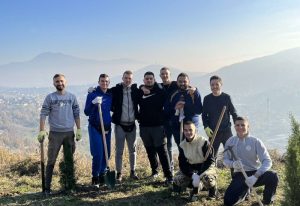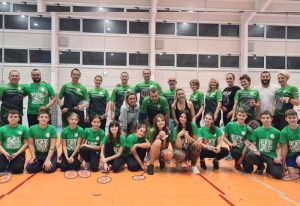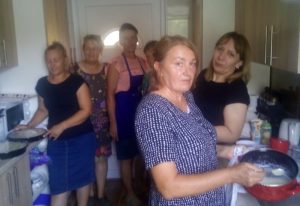Gradina as a source of inspiration and existence

Tesanj is one of the municipalities in Bosnia and Herzegovina that has the epithet of an economic miracle. In the municipality, which despite its specific location, away from the main roads, achieves extremely good economic and export results. Almost all industries are represented, and there are few unemployed among the approximately 40,000 inhabitants, yet young people leave. Among those who strive to enrich the cultural life of the bazaar on the banks of the Tesanjka river is Zoraid Mehicic, president of the Association “Stari grad”, activist, volunteer, humanist, pensioner, rock’n’roll lover.
“Welcome! How are you Zoraide, I haven’t seen you for a while?”, at the entrance to the Stari Grad, Sabiha Halilovic welcomes us as if we have arrived to her own house. She sells Tesanj souvenirs, souvenirs depicting the fortress, the old town and the image of the poet Musa Cazim Catic and the occasional book about Tesanj or Gradina. She is satisfied with the sales, since this year many tourists visited Tesanj. She offers us homemade juice and adds “Do you know that Zoraid is our legend, legend of Tesanj and the Stari Grad, and our Gradina is a national monument of Bosnia and Herzegovina?”. People from Tesanj call the Stari Grad on the hill Gradina. In July 2003, it was declared a Bosnian-Hrzegovinian national monument.
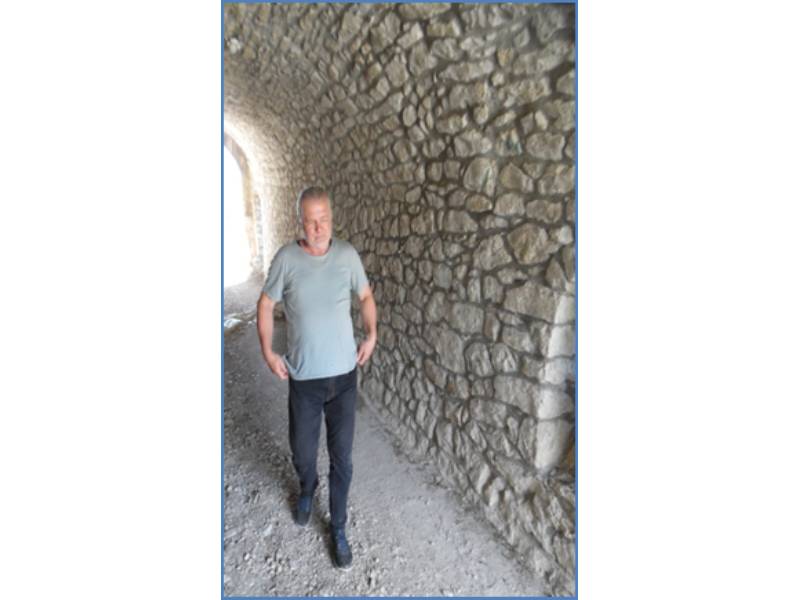
With Zoraid Mehicic, widely recognizable resident of Tesanj, we climb a demanding path to the towers and walls. The fortress with two towers was built on top of a rocky hill. It is not known who founded the city. Based on archaeological finds, historians assume that the city was inhabited by Illyrians, Romans, and Slavs.
“It is assumed that the name Tesanj comes from the Celtic word Tesen, which means small court, and it was first mentioned in a document in the fifteenth century,” Zoraid tells us.
We haven’t gone far. The smell of roses stops us for a while. By the bushes of red roses that climb up the stone wall, a young man mows. Mehicic presents him as the most valuable worker in Gradina, Kenan Hadzisehic.
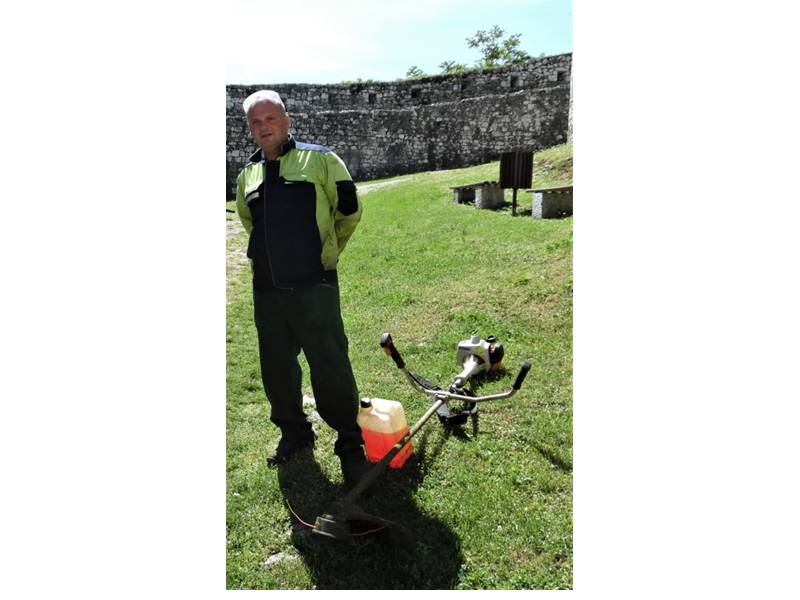
The roses were planted in 2009, he says with pride. When we asked him “How is it going?” he answers with a smile “Okay, it’s going slowly”. In the mood for a conversation, he adds that life is good in Tesanj and that it is beautiful. He was hired as a seasonal worker by the Public Institution Tesanj Museum for maintenance work. Hadzisehic has a contract from April to November. He has been cleaning the fortress for years, and he started as a volunteer with Zoraid Mehicic.
“For a year, we just cleaned graffiti. It was very neglected, but we managed to fix it and clean it. Later in 2011, it was taken over by the Tešanj Museum from the Association “Stari grad”.
From November to April, when he is not engaged in cleaning and maintenance, Kenan Hadzidehic makes wooden souvenirs with Tesanj motifs, which he sells in the souvenir shop in Gradina during the season.
“I work at home; I have a workshop. I make various objects and paintings. Business is going well, you can earn enough. It depends on what you want in life. If you are modest, you don’t need much. If you want something more, then you have to go to Germany, to the seaside and so on”.
He adds that young people are leaving Tesanj, and that there are not many options for entertainment. He is not thinking about leaving.
“I have no other country except Bosnia and Herzegovina, and it will remain so,” says Kenan Hadzisehic.
Among those who left is Zoraid’s daughter. Mehicic says that the number of young people leaving is not big, but it is growing. He thinks that Tesanj is a good place to live, but that it lacks content, mostly cultural.
“Although the writer Amir Brka, who is a recognized writer, lives and works here, theater, music, and sports are also part of cultural life. The ruling structures do not care about culture. It is noticeable in the city, but also around Gradina”.
Zoraid’s house overlooks Gradina, he grew up in that area. A few years after the war, a group of friends and enthusiasts started cleaning it.
”In the past, you couldn’t even enter here. We cleaned a lot of garbage, ten trucks of garbage. We have set some standards and we keep Gradina clean, tidy and safe”.
They started the cleaning action on their own initiative. The Tesanj Municipality recognized the value of the action and volunteerism of the members of the “Stari Grad” Association.
“They recognized that we are doing this with good intentions and even gave us the key. We were there for five years, everything was regulated. We used to charge entrance fees, but all this cannot be maintained from the entrance fees alone. At the moment when we started to get more serious, we had a man who was at the entrance, one who cleaned and a translator for several languages”, says Mehicic.
As we climb towards the plateau below the Captain’s Tower, we pass Dizdar’s Tower, which houses the permanent exhibition of the Tesanj Museum, Tesanj through the centuries until 1918. Among the exhibits are the Ottoman saber Semsi, a Hebrew manuscript of the story of Ester, a collection of Sufi qasidas in Arabic, the register of baptisms of the Komusin parish from 1699 to 1720, a budget proposal and seals from 1908.

This tower was named after the manager of the tower, dizdar. The captain who sat at the top of the tower managed the entire fortification, and the dizdar the crew in the tower, the soldiers who were in charge of the defense of the city.
According to Zoraid Mehicic, the plateau between the two towers is the most beautiful part of Tesanj’s Gradina. He says it is suitable for various cultural manifestations. On the landscaped plateau there is a stage, chairs, a fountain and another souvenir shop.

“This is well arranged. It can be seen that investments are being made in reconstruction. I have been to many other similar constructions, they are not maintained like Gradina”, says Mehicic.
There is also a cannon on the plateau. The most famous rocker from Tesanj says the cannon is not a threat, it has been out of use for a long time.
“I’m a rocker, a pacifist, I’m not really into shooting cannons. Although AC/DC has one album where cannons fire in the intro”.
Along with the story of the rock concerts for which he mostly travels to the countries of the region, but also the concerts organized by the Association “Stari grad” in Gradina, we come to the Captain’s Tower.
Some of Zoraid’s concert destinations were Sarajevo, Belgrade, Zagreb, Split, Kragujevac… performers Whitesnake, Deep Purple, Scorpions, Smak, Josipa Lisac… He is getting ready for Sting in Sarajevo.
”I love rock’n’roll and it is my life along with my family. Music gives me strength. Dino Merlin, Dubioza kolektiv, Divlje jagode, Regina, Divanhana sang in Gradina… Most of them were some of our friends, but financially we were mostly in the red”.
The Association “Stari grad” annually receives financial support of a maximum of three thousand BAM.
One of the activities for which the members of the Association from Tesanj often allocate their time and money is the art colony that they have been organizing for years in August.
“In addition to painters from our country, there were painters from Austria, Slovenia, Serbia and Croatia. Our optimum is eight people and three days. However, that is also very difficult because we, as an Association, provide accommodation, food, canvas, paints”, says Mehicic.
The captain’s tower and kazamat are the medieval part of the fortress.

There is a numismatic exhibition in kazamat. Coins from the Roman Empire, the Middle Ages, the Ottoman Empire, the Austro-Hungarian Empire and the modern era are on display.
In the Captain’s Tower, there is a permanent museum exhibition of Charters, letters and seals of Bosnian rulers. They are mostly replicas, only a few originals are kept in the National Museum of Bosnia and Herzegovina, and the rest of the originals are in the State Archives in Dubrovnik.
Among the documents on display, along with the replica of the Kulin Ban Charter, there are several documents that bear witness to Bosnian involvement in the conflict between the Ottoman and Serbian states in Kosovo in 1389, says Jasmin Mandzukic from the Tesanj Museum.
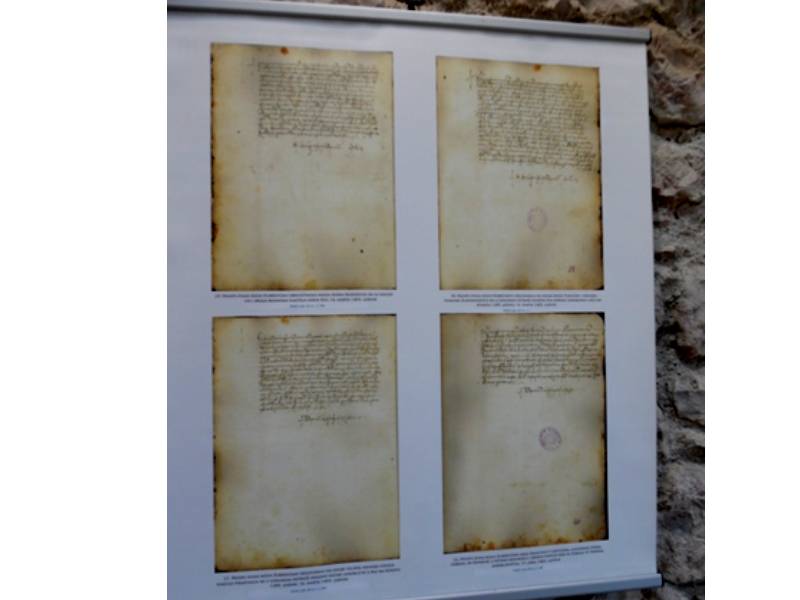
“A detachment of Bosnian cavalry with Duke Vlatko Vukovic also participated in that battle. The flower of the Bosnian nobility was captured. The Bosnian court sent a letter to the people of Dubrovnik asking them to check the fate of the prisoners. They got the answer in 1402. Prince Vukmir and Prince Vukasin of the prince Zlatonosovic are alive and well on the island of Lesvos. The nobility managed to return to medieval Bosnia by ransom or escape. We have one such interesting document on display”, explains Jasmin Mandzukic.
The Captain’s Tower is mentioned in a charter from 1461, a document by which the last king of the medieval Bosnian kingdom, Stjepan Tomasevic, presented the tower to his uncle Radivoje.
From the top of Gradina, you can enjoy a panoramic view of the Tesanj Municipality. With a lot of love, Zoraid Mehicic shows the industrial zone, the famous Eminagica inn. He also shows several old Bosnian houses which, as he says, are welcoming guests. The municipal building from the Austro-Hungarian period, the House of Culture, the Primary School named after Husein Hodzic, a national hero from the Second World War, to the far-famed Tesanj General Hospital.
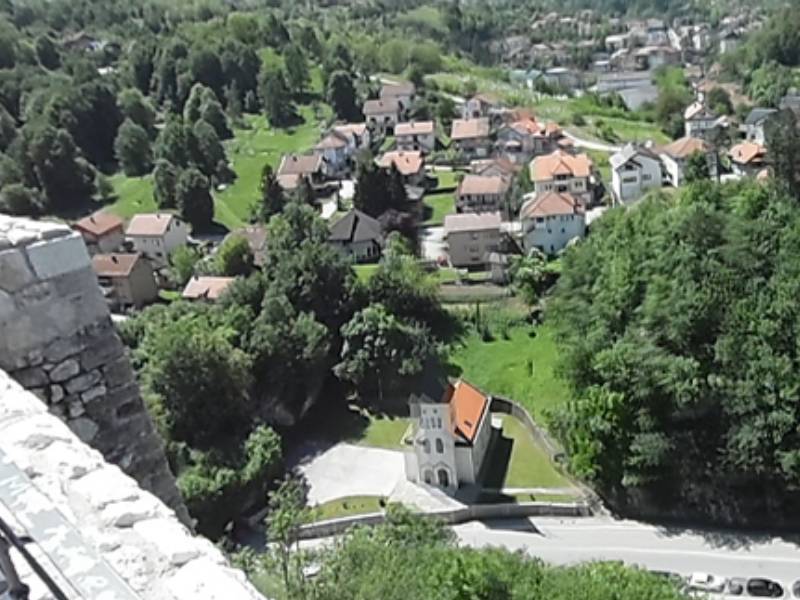
“You can see an Orthodox church, a Catholic church and a mosque. There are few places that have these facilities so close. And I’m proud of that. It was a war, every day a hundred shells fell on Tesanj from the surrounding hills, and no one damaged these buildings”, points out Zoraid Mehicic.
Tesanj’s economy has always been strong. Today there are at least ten strong export companies.
“Whoever wants to work can find a job”.
There are almost no unemployed people in Tesanj, but there is a considerable number of pensioners. Zoraid is also in that category, receiving an average pension in the Federation of BiH of around 500 BAM. He says he had a high salary, but the company paid contributions in the amount of the minimum salary.
”As Zuko Dzumhur says, a piece of cheese, a piece of bread and a glass of brandy might be too much. You have to accept life as it is and fight to make it better”, adds Mehicic.
In order for life to be better, capable and smart people must come, and only then we can hope for a better future.
“And to discuss the election law for a hundred years like this is rubbish, and the verdict of Sejdic-Finci remains unimplemented”. Here people have come to terms with it. “Peace is the most important thing, but here after the war, a freakish system was set up so that we can’t even reach that peace.”
The announcement of Sting’s concert in Sarajevo raises Zoraid’s hope that things will get better. He says that if the concert is held, he has some hope.
“When I go to a concert, people say have a good time. Basically, when you go to a concert, you’ll have a good time, I don’t go to sports matches to yell and swear at each other.”
Without culture, there is nothing, everything is for nothing if there is no culture, he points out.
“Culture is also the fact that Gradina is clean. Culture is also good behavior. Culture is everything, if there is no culture, then there is no hope or progress”, concludes Zoraid Mehicic, Tesanj’s rocker, activist, humanist, president of the “Stari grad” Association.
From the sun-bathed Stari Grad Tesanj, we are sent off with a glass of cold home-made juice by Sabiha Halilovic with a message “Enjoy our city!”. On the stairs leading from the Gradina, Kenan Hadzimesic greets us with the sentence “All the best Bosnia and Herzegovina!”


